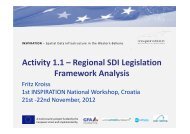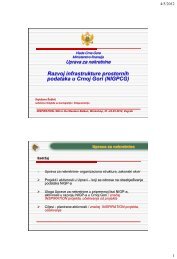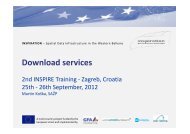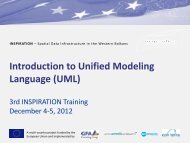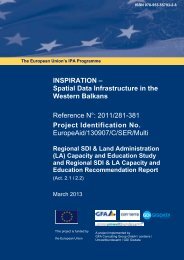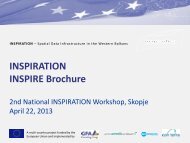MOVE - Moderation and Visualization for Group ... - INSPIRATION
MOVE - Moderation and Visualization for Group ... - INSPIRATION
MOVE - Moderation and Visualization for Group ... - INSPIRATION
You also want an ePaper? Increase the reach of your titles
YUMPU automatically turns print PDFs into web optimized ePapers that Google loves.
Be<strong>for</strong>e we go into the details of the four<br />
competences at work, it may be useful to take a<br />
closer look at one of the procedures that you will<br />
use very often - collecting <strong>and</strong> structuring ideas<br />
on cards:<br />
■ As the moderator, you read the visualized<br />
question out aloud <strong>and</strong> ask whether it is<br />
understood.<br />
■ Each participant is given a number of cards.<br />
You may limit the number of cards per<br />
individual or per group if time constraints or<br />
board space are a concern <strong>for</strong> later<br />
presentations.<br />
■ Each participant, or several participants as a<br />
buzz group, writes down his or her answers or<br />
ideas: One idea - one card.<br />
■ You collect the cards after everybody has<br />
finished writing. You may mix the cards in<br />
order to avoid individual sequences <strong>and</strong><br />
preserve anonymity.<br />
■ You read the cards to the group by holding<br />
them up, then pin them r<strong>and</strong>omly. Remember<br />
that about 30 cards fit on a st<strong>and</strong>ard board<br />
with enough space between them, so that you<br />
can cluster them together later.<br />
■ In a second step, cluster the cards together<br />
according to the suggestions or structure<br />
proposed by the participants. Cards that<br />
belong to several clusters should be doubled.<br />
■ The different clusters of cards should be<br />
surrounded by a line, like a ‘cloud.’ This<br />
constitutes a ‘map’ or ‘poster’ of the group’s<br />
opinion.<br />
■ Headings <strong>for</strong> these clusters should be<br />
<strong>for</strong>mulated by or with the group. It may be<br />
meaningful <strong>for</strong> the group to put the ‘clouds’ in<br />
a sequential or priority order, or to decide<br />
which headings should be dealt with in<br />
greater detail.<br />
■ To identify gaps, you may ask „What is<br />
missing?.“<br />
■ The group finally discusses <strong>and</strong> analyzes the<br />
conclusions, adding further cards, if<br />
necessary.<br />
■ By the end of the day, you should attach a<br />
number code in the lower right corner of each<br />
‘poster’ <strong>for</strong> documentation purposes or a<br />
photo report. In addition to a consecutive<br />
number <strong>for</strong> each poster, you may indicate the<br />
date <strong>and</strong> the number of the session during the<br />
34<br />
day. This will keep track of the many posters<br />
with group or plenary results generated<br />
throughout an event.<br />
This way of collecting <strong>and</strong> structuring ideas on<br />
cards has proven to be the ‘bread <strong>and</strong> butter’ tool<br />
<strong>for</strong> brainstorming, or ‘brainwriting’ as this tool is<br />
sometimes refered to. It tends to be so closely<br />
identified with <strong>MOVE</strong> that it often becomes<br />
overused. But there are other tools <strong>and</strong> there is<br />
more than brainstorming to moderation <strong>and</strong><br />
visualization methods. The methods <strong>and</strong><br />
instruments depend on the function <strong>and</strong> purpose<br />
of a given event (see Will 2001): <strong>for</strong>m follows<br />
function. Here are some potential functions of<br />
an event <strong>and</strong> the suitable methods <strong>and</strong> tools that<br />
go along with it:



